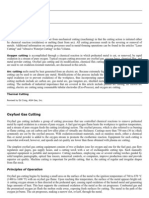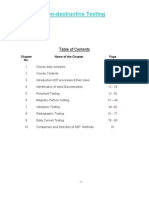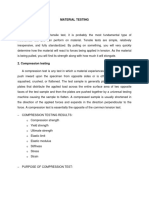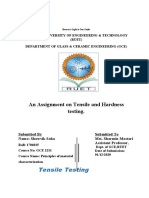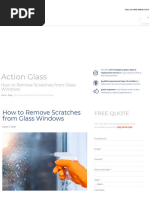Destructive Testing
Uploaded by
Abdul RehmanDestructive Testing
Uploaded by
Abdul RehmanDestructive Testing:Destructive testing is a test that puts the sample object under certain circumstances until it actually fails.
The failed pieces are then studied and compared with known standards to determine the quality of the object. This type of testing is generally much easier to carry out, more likely to yield more information & much easier to interpret Non-destructive testing. Its drawback is that after performing test material cannot be reused. Method of Destructive testing are as follows
Compression test :Compression testing is used to establish the compressive force or crush resistance of a material and the ability of the material to recover after a specified compressive force is applied and even held over a defined period of time. Compression tests are used to determine the material behavior under a load. The maximum stress a material can sustain over a period under a load (constant or progressive) is determined
Tensile Testing:Tensile testing, also known as tension testing,is a fundamental materials science test in which a sample is subjected to a controlled tension until failure. The results from the test are commonly used to select a material for an application, for quality control, and to predict how a material will react under other types of forces. Properties that are directly measured via a tensile test are ultimate tensile strength, maximum elongation and reduction in area.[2] From these measurements the following properties can also be determined: Young's modulus, Poisson's ratio, yield strength, and strain-hardening characteristic
Bending Test:Bend testing determines the ductility or the strength of a material by bending the material over a given radius. Following the bend, the sample is inspected for cracks on the outer surface. Bend testing provides insight into the modulus of elasticity and the bending strength or a material. The three-point bending flexural test provides values for the modulus of elasticity in bending Ef, flexural stress f, flexural strain f and the flexural stress-strain response of the material. The main advantage of a three point flexural test is the ease of the specimen preparation and testing. It also helps to determine shape Factor
Torsion Test:Torsion test is the method for determining behavior of materials subjected to twisting loads. Data from torsion test is used to construct a stress-strain diagram and to determine elastic limit torsional modulus of elasticity, modulus of rupture in torsion, and torsional strength. Shear properties are often determined in a torsion test
Hydrostatic test:A hydrostatic test is a way in which pressure vessels such as pipelines, plumbing, gas cylinders, boilers and fuel tanks can be tested for strength and leaks. The test involves filling the vessel or pipe system with a liquid, usually water, which may be dyed to aid in visual leak detection, and pressurization of the vessel to the specified test pressure. Pressure tightness can be tested by shutting off the supply valve and observing whether there is a pressure loss. The location of a leak can be visually identified more easily if the water contains a colorant. Strength is usually tested by measuring permanent deformation of the container. Hydrostatic testing is the most common method employed for testing pipes and pressure vessels. Using this test helps maintain safety standards and durability of a vessel over time. The test pressure is always considerably higher than the operating pressure to give a margin for safety (typically 166.66%, 143% or 150% of the designed pressure
Impact test:A test designed to give information on how a specimen of a known material will respond to a suddenly applied stress, e.g. shock. The test ascertains whether the material is tough or brittle. A notched test piece is normally employed and the two methods in general use are either the Izod or Charpy test. The result is usually reported as the energy in ft.lbs. or KJ. required to fracture the test piece.
Hardness test:Hardness is a measure of how resistant solid matter is to various kinds of permanent shape change when a force is applied. Indentation hardness tests are used to determine the hardness of a material to deformation. Several such tests exist (like Brinell Hardness Number, Rockwell Hardness Number, ASTM Hardness Number, Diamond Pyramid Impact Test Hardness Number, Durometer Hardness, Knoop Hardness, and Pfund Hardness),wherein the examined material is indented until an impression is formed. A table relating various types of hardness values of metals is given in ASTM E-140. Hardness often is a good indication of tensile and wear properties of a material.
Fatigue Test:Fatigue tests are made with the object of determining the relationship between the stress range and the number of times it can be applied before causing failure. Testing machines are used for applying cyclically varying stresses and cover tension, compression, torsion and bending or a combination of these stresses. The test is of two types.Low Cycle Fatigue (LCF) describes the service environment of many critical (and primarily metal) components: low frequency, large loads/strains.High Cycle Fatigue (HCF) results from vibratory stress cycles at frequencies
which can reach thousands of cycles per second and can be induced from various mechanical sources.
Creep test:Deformation that occurs over a period of time when a material is subjected to constant stress at constant temperature . The test specimen design is based on a standard tensile specimen. The creep test is conducted using a tensile specimen to which a constant stress is applied, often by the simple method of suspending weights from it. Surrounding the specimen is a thermostatically controlled furnace, the temperature being controlled by a thermocouple attached to the gauge length of the specimen. The extension of the specimen is measured by a very sensitive extensometer since the actual amount of deformation before failure may be only two or three per cent. The results of the test are then plotted on a graph of strain versus time to give a curve
Non-Destructive Testing:Nondestructive testing or Non-destructive testing (NDT) is a wide group of analysis techniques used in science and industry to evaluate the properties of a material, component or system without causing damage Because NDT does not permanently alter the article being inspected, it is a highly valuable technique that can save both money and time in product evaluation, troubleshooting, and research. Methods of Non-Destructive testing are as follows
X-Rays Test:X-ray testing is the method of inspecting materials for hidden flaws by using the ability of short wavelength electromagnetic radiation (high energy photons) to penetrate various materials. Since the amount of radiation emerging from the opposite side of the material can be detected and measured, variations in this amount (or intensity) of radiation are used to determine thickness or composition of material.
Magnetic Particle Inspection Test:Its a process for detecting surface and slightly subsurface discontinuities in ferromagnetic materials such as iron, nickel, cobalt, and some of their alloys The test includes a magnetic field into the ferrous object coated with iron particles that are either dry or suspended in liquid. Surface imperfections will disort the magnetic field, causing an accumulation of iron particles near imperfections thus indicating their presence in the material.
Dye Penetrant Test:-
Dye penetrant or penetrant testing (PT), is an inspection method used to locate surface-breaking defects in all non-porous materials (metals, plastics, or ceramics). The penetrant may be applied to all non-ferrous materials and ferrous materials, although for ferrous components magnetic-particle inspection is often used instead for its subsurface detection capability. LPI is used to detect casting, forging and welding surface defects such as hairline cracks, surface porosity, leaks in new products, and fatigue cracks on inservice component
Ultrasonic Test:In ultrasonic testing, very short ultrasonic pulse-waves with center frequencies ranging from 0.1-15 MHz and occasionally up to 50 MHz are transmitted into materials to detect internal flaws or to characterize materials. Ultrasonic testing is often performed on steel and other metals and alloys, though it can also be used on concrete, wood and composites, albeit with less resolution. This testing is used in many industries including aerospace, automotive and other transportation sectors.
Standards:Standards are something used as a measure, norm, or model in comparative evaluations. The Following are some of the standards that are used in Material sciences
ASTM (American Society for Testing and Materials)
ASTM International, known as the American Society for Testing and Materials (ASTM), is an international standards organization that develops and publishes voluntary consensus technical standards for a wide range of materials, products, systems, and services. The standards produced by ASTM International fall into six categories: 1. Standard Specification Defines the requirements to be satisfied by subject of the standard 2. Standard Test Method Defines the way a test is performed and the precision of the result. The result of the test may be used to assess compliance with a Standard Specification 3. Standard Practice Defines a sequence of operations that, unlike a Standard Test Method, does not produce a result 4. Standard Guide Provides an organized collection of information that does not recommend a specific course of action 5. Standard Classification Provides an arrangement or division of materials, products, systems, or services into groups based on similar characteristics such as origin, composition, properties, or use 6. Terminology Standard Provides agreed definitions of terms used in the other standards.
JIS (Japanese Industrial Standards)
Japanese Industrial Standards (JIS) specifies the standards used for industrial activities in Japan. The standardization process is coordinated by Japanese Industrial Standards Committee and published through Japanese Standards Association.
JIS covers industrial and mineral products with the exception of 1. Medicines Standardization and 2. Agricultural chemicals Proper Labelling of 3. Chemical fertilizers Agricultural and Forestry 4. Silk yarn Products 5. Foodstuffs, agricultural and forest products designated under the Law Concerning
The, letter symbol indicates the technical area (JIS Division), and the 4-digit or 5-digit number is added to locate the JIS in an appropriate place within that Division (see the explanation in Figure 6)Divisions of JIS and significant standards are: A Civil Engineering and Architecture F Ship building B Mechanical Engineering G Ferrous Materials and Metallurgy C Electronic and Electrical Engineering H Nonferrous materials and metallurgy[1] D Automotive Engineering K Chemical Engineering E Railway Engineering L Textile Engineering
M Mining P Pulp and Paper Q Management System R Ceramics S Domestic Wares
T Medical Equipment and Safety Appliances W Aircraft and Aviation X Information Processing Z Miscellaneous
ISO (International Organization for Standardization)
The International Organization for Standardization is an international standardsetting body composed of representatives from various national standards organizations. It is headquartered in Geneva, Switzerland. ISO's main products are international standards. ISO also publishes technical reports, technical specifications, publicly available specifications, technical corrigenda, and guides Technical reports are issued when a technical committee or subcommittee has collected data of a different kind from that normally published as an International Standard. Technical specifications can be produced when "the subject in question is still under development or where for any other reason there is the future but not immediate possibility of an agreement to publish an International Standard". Corrigenda are amendments to existing standards because of minor technical flaws, usability improvements, or limited applicability extensions. ISO Guides are meta-standards covering "matters related to international standardization"
ASME (American Society of Mechanical Engineers)
ASME produces approximately 600 codes and standards, covering many technical areas, such as boiler components, elevators, and measurement of fluid flow in closed conduits, cranes, hand tools, fasteners, and machine tools. A Standard can be defined as a set of technical definitions and guidelines that function as instructions for designers, manufacturers, operators, or users of equipment. A standard becomes a Code when it has been adopted by one or more governmental bodies and is enforceable by law, or when it has been incorporated into a business contract.
ASME Boiler and Pressure Vessel Code (BPVC) The largest ASME standard, both in size and in the number of volunteers involved in its preparation, is the ASME Boiler and Pressure Vessel Code (BPVC). BPVC is a standard that provides rules for the design, fabrication, and inspection of boilers and pressure vessels. It is reviewed every two years. The BPVC consists of twelve volumes on following domains: Power Boilers Heating Boilers
Pressure Vessels Fibre-Reinforced Pressure Vessels Transport Tanks Nuclear Construction Nuclear In-service Inspection Service Section
ASME Performance Test Codes (PTC) ASME Performance Test Codes (PTCs) provide uniform rules and procedures for the planning, preparation, execution, and reporting of performance test results. The codes provide guidelines for test procedures that yield results taking into account test costs and the value of information obtained from testing. They are meant specifically for equipment operating in an industrial setting. Detailed compartments of PTC involve: ASME General Documents on Guiding Information ASME General Documents on Measurement of Process Parameters and Associated Phenomena ASME PTCs on Combustion and Heat Transfer ASME General Document on Analytical Techniques ASME PTCs on Emissions ASME PTCs on Fluid Handling ASME PTCs on Power Production
TEMA (Tubular Exchanger Manufacturers Association)
The Tubular Exchanger Manufacturers Association, Inc. (TEMA) is trade association of leading manufacturers of shell and tube heat exchangers, who have pioneered the research and development of heat exchangers TEMA is a set of standards developed by leading heat exchanger manufacturers that defines the design and manufacturing parameters of shell and tube type heat exchangers. TEMA is comprised of three different classes to categorize designs; TEMA R, TEMA B & TEMA C. In addition, TEMA developed Recommended Good Practice, for situations not covered by the three established classes. All TEMA Classes comply with ASME Section VIII, Division 1. TEMA R: Unfired shell and tube heat exchangers for the generally severe requirements of petroleum and related processing applications. TEMA B: Unfired shell and tube heat exchangers for chemical process service. TEMA C: Unfired shell and tube heat exchangers for the generally moderate requirements of commercial and general process application
You might also like
- Guide For Design and Construction With Autoclaved Aerated Concrete Panels100% (1)Guide For Design and Construction With Autoclaved Aerated Concrete Panels88 pages
- Rational CombiMaster Plus 202E Service Manual100% (1)Rational CombiMaster Plus 202E Service Manual56 pages
- Ultrasonic - Calibration Inspection ChecklistNo ratings yetUltrasonic - Calibration Inspection Checklist2 pages
- Approved Hardness Procedure (RC-Code-1) TF&TD-N-L-0652-14100% (3)Approved Hardness Procedure (RC-Code-1) TF&TD-N-L-0652-1411 pages
- Mechanical Properties of Charpy Impact TestNo ratings yetMechanical Properties of Charpy Impact Test14 pages
- Destructive Testing of Welds in WPS-PQR Preparation100% (2)Destructive Testing of Welds in WPS-PQR Preparation58 pages
- Welding Program Quality Assurance GuideNo ratings yetWelding Program Quality Assurance Guide18 pages
- Method Statement FOR Ultrasonic Testing: Arab Center For Engineering StudiesNo ratings yetMethod Statement FOR Ultrasonic Testing: Arab Center For Engineering Studies10 pages
- Pressure Gauge Calliberation ExperimentNo ratings yetPressure Gauge Calliberation Experiment17 pages
- NDT Magnetic Particle Inspection ProcedureNo ratings yetNDT Magnetic Particle Inspection Procedure7 pages
- Code, Standard, Specification and ProcedureNo ratings yetCode, Standard, Specification and Procedure13 pages
- Unit 4 - Materials Technology - WWW - Rgpvnotes.inNo ratings yetUnit 4 - Materials Technology - WWW - Rgpvnotes.in24 pages
- Chapter 7 - Destructive and Non Destructive Testing of MaterialNo ratings yetChapter 7 - Destructive and Non Destructive Testing of Material33 pages
- Material Science and Engineering DJJ 30113No ratings yetMaterial Science and Engineering DJJ 3011318 pages
- MECHANICAL TESTING AND INSPECTION OF MATERIALSNo ratings yetMECHANICAL TESTING AND INSPECTION OF MATERIALS6 pages
- ME 8097-Non Destructive Testing And: EvaluationNo ratings yetME 8097-Non Destructive Testing And: Evaluation22 pages
- Group 4 (Toledo, Toring, Valencerina) Materials Testing (4-7)No ratings yetGroup 4 (Toledo, Toring, Valencerina) Materials Testing (4-7)44 pages
- Assignment #5 CE05L (PCEIT-02-401P) (Delos Santos, Gerald)No ratings yetAssignment #5 CE05L (PCEIT-02-401P) (Delos Santos, Gerald)6 pages
- Materials Testing: Deadlines: Assignment 1 Submission: 22 December 2020 Assignment 2 Submission: 19 January 2021No ratings yetMaterials Testing: Deadlines: Assignment 1 Submission: 22 December 2020 Assignment 2 Submission: 19 January 202141 pages
- ME8097-LN - by WWW - Easyengineering.net 2No ratings yetME8097-LN - by WWW - Easyengineering.net 277 pages
- 3 - CEM - Testing of Mechanical Properties PDFNo ratings yet3 - CEM - Testing of Mechanical Properties PDF11 pages
- Destructive Testing EMM Presentation (Group 1)No ratings yetDestructive Testing EMM Presentation (Group 1)28 pages
- Distructive & Non-Destructive Testing of MaterialNo ratings yetDistructive & Non-Destructive Testing of Material16 pages
- Unit - 1 NDT - An Introduction: What Is Nondestructive Testing?100% (1)Unit - 1 NDT - An Introduction: What Is Nondestructive Testing?12 pages
- AE182MLERA Haier Built in Floor Standing ManualNo ratings yetAE182MLERA Haier Built in Floor Standing Manual3 pages
- Area Req Cooling Req Heating SQ - FT BTU/hr BTU/hr Sr. No Description Tonnage Smoking Grill Cooling Load Calculation Sheet CFMNo ratings yetArea Req Cooling Req Heating SQ - FT BTU/hr BTU/hr Sr. No Description Tonnage Smoking Grill Cooling Load Calculation Sheet CFM1 page
- AutoCAD One-Key Shortcut Guide - AutoCAD Commands - Autodesk StoreNo ratings yetAutoCAD One-Key Shortcut Guide - AutoCAD Commands - Autodesk Store14 pages
- BHEL - Technical Specification AC Distribution BoardsNo ratings yetBHEL - Technical Specification AC Distribution Boards63 pages
- Presentation On Co-Op Training: Nuclear Power Corporation of India Limited (A Government of India Enterprise)No ratings yetPresentation On Co-Op Training: Nuclear Power Corporation of India Limited (A Government of India Enterprise)14 pages
- How To Remove Scratches From Glass WindowsNo ratings yetHow To Remove Scratches From Glass Windows4 pages
- JIS_G_5502 Year 2022 Spheroidal Graphite Cast Irons100% (1)JIS_G_5502 Year 2022 Spheroidal Graphite Cast Irons111 pages
- Strength of Single-Phase High-Entropy Carbide Ceramics Up To 2300°CNo ratings yetStrength of Single-Phase High-Entropy Carbide Ceramics Up To 2300°C25 pages
- Gledhill Torrent Re Solar Installation GuideNo ratings yetGledhill Torrent Re Solar Installation Guide16 pages
- Unit Estimate - Rectangular Brick ManholeNo ratings yetUnit Estimate - Rectangular Brick Manhole8 pages
- Power Imprint Builders and Trading Phils. Corp.: Design - Engineering - Construction - ConsultancyNo ratings yetPower Imprint Builders and Trading Phils. Corp.: Design - Engineering - Construction - Consultancy8 pages
- toaz.info-list-of-construction-prices-for-electrical-works-philippines-philcon-prices-pr_aa74796daad0a6ffda9d2121c52a9d22No ratings yettoaz.info-list-of-construction-prices-for-electrical-works-philippines-philcon-prices-pr_aa74796daad0a6ffda9d2121c52a9d224 pages
- 5 - SPM LN-11 - 14 - 18 - 25 - 35 - 60 TP - 2015-12No ratings yet5 - SPM LN-11 - 14 - 18 - 25 - 35 - 60 TP - 2015-1235 pages
- Modul 5 Pondasi 2 Turap Berjangkar Di Tanah PasirNo ratings yetModul 5 Pondasi 2 Turap Berjangkar Di Tanah Pasir19 pages
- ENGINEERING DESIGN GUIDELINE-Relief Valves - Rev 02 PDFNo ratings yetENGINEERING DESIGN GUIDELINE-Relief Valves - Rev 02 PDF30 pages
- Guide For Design and Construction With Autoclaved Aerated Concrete PanelsGuide For Design and Construction With Autoclaved Aerated Concrete Panels
- Approved Hardness Procedure (RC-Code-1) TF&TD-N-L-0652-14Approved Hardness Procedure (RC-Code-1) TF&TD-N-L-0652-14
- Destructive Testing of Welds in WPS-PQR PreparationDestructive Testing of Welds in WPS-PQR Preparation
- Method Statement FOR Ultrasonic Testing: Arab Center For Engineering StudiesMethod Statement FOR Ultrasonic Testing: Arab Center For Engineering Studies
- Unit 4 - Materials Technology - WWW - Rgpvnotes.inUnit 4 - Materials Technology - WWW - Rgpvnotes.in
- Chapter 7 - Destructive and Non Destructive Testing of MaterialChapter 7 - Destructive and Non Destructive Testing of Material
- Group 4 (Toledo, Toring, Valencerina) Materials Testing (4-7)Group 4 (Toledo, Toring, Valencerina) Materials Testing (4-7)
- Assignment #5 CE05L (PCEIT-02-401P) (Delos Santos, Gerald)Assignment #5 CE05L (PCEIT-02-401P) (Delos Santos, Gerald)
- Materials Testing: Deadlines: Assignment 1 Submission: 22 December 2020 Assignment 2 Submission: 19 January 2021Materials Testing: Deadlines: Assignment 1 Submission: 22 December 2020 Assignment 2 Submission: 19 January 2021
- Unit - 1 NDT - An Introduction: What Is Nondestructive Testing?Unit - 1 NDT - An Introduction: What Is Nondestructive Testing?
- Area Req Cooling Req Heating SQ - FT BTU/hr BTU/hr Sr. No Description Tonnage Smoking Grill Cooling Load Calculation Sheet CFMArea Req Cooling Req Heating SQ - FT BTU/hr BTU/hr Sr. No Description Tonnage Smoking Grill Cooling Load Calculation Sheet CFM
- AutoCAD One-Key Shortcut Guide - AutoCAD Commands - Autodesk StoreAutoCAD One-Key Shortcut Guide - AutoCAD Commands - Autodesk Store
- BHEL - Technical Specification AC Distribution BoardsBHEL - Technical Specification AC Distribution Boards
- Presentation On Co-Op Training: Nuclear Power Corporation of India Limited (A Government of India Enterprise)Presentation On Co-Op Training: Nuclear Power Corporation of India Limited (A Government of India Enterprise)
- JIS_G_5502 Year 2022 Spheroidal Graphite Cast IronsJIS_G_5502 Year 2022 Spheroidal Graphite Cast Irons
- Strength of Single-Phase High-Entropy Carbide Ceramics Up To 2300°CStrength of Single-Phase High-Entropy Carbide Ceramics Up To 2300°C
- Power Imprint Builders and Trading Phils. Corp.: Design - Engineering - Construction - ConsultancyPower Imprint Builders and Trading Phils. Corp.: Design - Engineering - Construction - Consultancy
- toaz.info-list-of-construction-prices-for-electrical-works-philippines-philcon-prices-pr_aa74796daad0a6ffda9d2121c52a9d22toaz.info-list-of-construction-prices-for-electrical-works-philippines-philcon-prices-pr_aa74796daad0a6ffda9d2121c52a9d22
- 5 - SPM LN-11 - 14 - 18 - 25 - 35 - 60 TP - 2015-125 - SPM LN-11 - 14 - 18 - 25 - 35 - 60 TP - 2015-12
- ENGINEERING DESIGN GUIDELINE-Relief Valves - Rev 02 PDFENGINEERING DESIGN GUIDELINE-Relief Valves - Rev 02 PDF


















